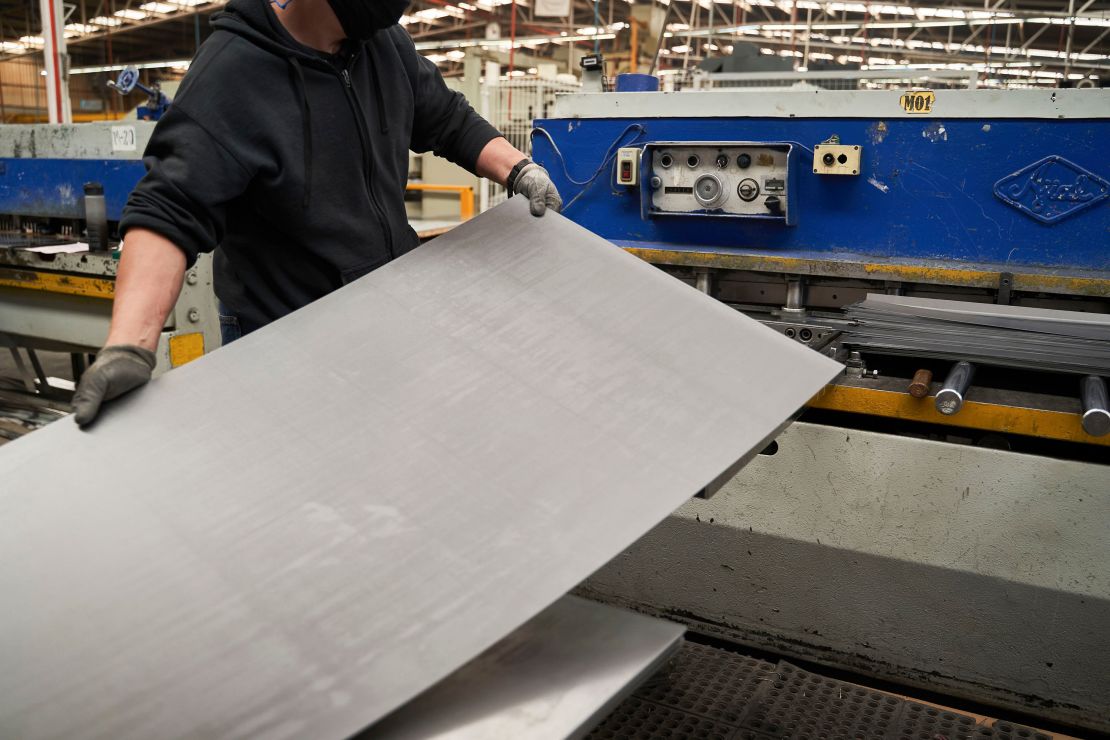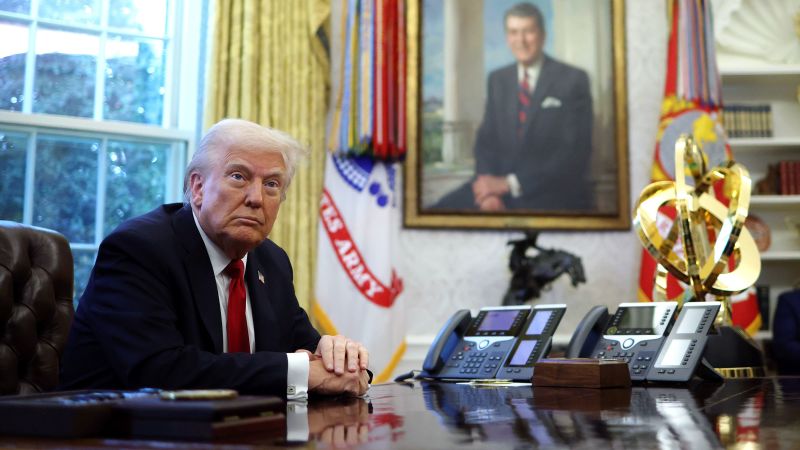CNN
—
President Donald Trump is set to gamble the success of his second term, the economy and the personal finances of millions of Americans this week on his long-held belief that tariffs can re-create a golden age of US wealth and independence.
Or is he? Such is Trump’s capricious leadership that nothing is certain until it happens. And adamant orders — especially on trade — are often reversed as soon as they are given.
But Trump promises that Wednesday, April 2, will be “Liberation Day” — when he imposes reciprocal dollar-for-dollar tariffs on nations that levy duties on US goods.
His most robust move yet to transform the global trading system could end up affecting every American, raising prices at a time when family budgets are already stretched. But the president is implicitly asking everyone to buy into a strategy that promises tantalizing future benefits but requires sacrifice for years to come.
Trump’s trade-war policies have already wiped trillions of dollars of stock markets — the Dow Jones Industrial Average plunged 700 points on Friday alone — and worsened fears of a recession as consumer confidence ebbs. He’s also alienated US allies as his foreign policy starts to unravel the Western system of alliances.
As Wednesday’s deadline approaches, the president is further damaging the confidence on which economic stability depends by raising contradictory expectations — suggesting, for instance, that some nations or industries may get opt-outs from the new tariffs. His whiplash leadership risks as much damage as the policies themselves.
Trump reasons that by imposing tariffs on imports, he’ll force firms to relocate manufacturing and supply chains to the United States, thereby creating jobs and reviving regions left destitute by globalization.
The downside, however, is that tariffs will spike prices for consumers weary of the high cost of living. And there’s no guarantee firms will bring production back stateside, since such a reorientation would take years and presumably outlast Trump’s time in power.
If the president follows through, he’ll be taking a huge political risk. But he seems oblivious to the potential impact. In a stunning comment to NBC News’ Kristen Welker on Saturday, the billionaire who heads a Cabinet of billionaires and millionaires was indifferent to hikes in the cost of autos caused by his new industry tariffs.
“I couldn’t care less if they raise prices, because people are going to start buying American-made cars,” Trump said in a telephone interview. “I couldn’t care less, because if the prices on foreign cars go up, they’re going to buy American cars.”
His attitude risks a political backlash when Republicans are already wary about the electoral impact of a slowing economy and Trump’s policies, with Florida special elections for the House this week threatening to embarrass the party.
Trump’s view also ignores the complexity of the 25% auto tariffs set to go into effect this week. Manufacturing processes are deeply integrated with plants in Mexico and Canada. This means that most cars built in the US will become more expensive. And while in theory a US-made car in the future could be immune from tariffs, higher production costs and investment needed to site manufacturing solely inside the United States will be passed on to consumers. In the intervening years, the price of new cars will be thousands of dollars higher, risking industry job cuts.

Winners and losers
Trump’s belief in the almost mystical power of tariffs is rooted in his worldview of winners and losers and his conviction that the US has long been ripped off by European and Asian powers that protect their industries.
“We’re going to charge countries for doing business in our country and taking our jobs, taking our wealth, taking a lot of things that they’ve been taking over the years,” Trump told reporters last week. “They’ve taken so much out of our country, friend and foe.”
Tariff policy is as old as the United States. But many economists blame restrictive trade policy for causing immense hardship in the Great Depression in the 1930s, and the post-World War II period saw the gradual lowering of trade barriers before a radical reshaping of global commerce as the 21st century dawned.
Trump refuses to accept the economic consensus that tariffs cause higher prices because importers pass the costs of extra duties on to consumers. This is a particular concern as voters haven’t had much relief from hikes in the cost of vital goods during the pandemic years. Inflation may have abated, despite signs it’s ticking up again, but the cost of living hasn’t returned to where it was five years ago.
The president’s goal of trying to revive economic prospects in areas hammered by the loss of factories is laudable. The economic transformation wrought by globalization has been painful, stripping communities of prospects and contributing to the opioid epidemic. Administration officials argue Trump’s policies will restore Main Streets scarred by rows of closed shops.
The sense of loss in Rust Belt areas fueled Trump’s political rise as he latched onto the anger of regular Americans more effectively than other politicians of his generation.
There is no question that the promises of past officials about globalization’s power to make every single American richer were not borne out by results. And Trump’s trade transformation is fueled by those broken pledges.
One of the arguments for expanding free trade and letting China into the World Trade Organization, for instance, was that it would liberalize the communist giant and make it less of a threat to the United States. But there was also an economic argument that it would make US jobs more secure.
“For the first time, our companies will be able to sell and distribute products in China made by workers here in America without being forced to relocate manufacturing to China, sell through the Chinese government, or transfer valuable technology,” President Bill Clinton said in March 2000. “We’ll be able to export products without exporting jobs.”
That argument looks hollow to many Americans a quarter of a century on. And while it seemed logical to try to promote political reform in China through economic policy, Beijing instead used trade concessions to bankroll its rise to superpower status and to cement its repressive domestic state.
But is the president’s idealized view of a future US economy realistic?
Re-creating a 1950s-style idyll of American manufacturing is a stretch in an era when the US competitive edge and economic might is centered on service industries, technology and the rise of jobs and commerce based on artificial intelligence.
While other economies — Canada, for instance — stand to lose in a trade war with the more powerful United States, they can still inflict great pain on American consumers.
And Trump’s own unpredictability — extending deadlines, offering exceptions to tariffs, reversing his policy and then doubling down — is also counterproductive, and not just because it has hammered the market-based retirement savings of millions of Americans.
The specter of a volatile politician trying to personally manipulate the global economy according to his hourly whims risks disaster. And it’s fostering uncertainty that will discourage manufacturers from coming home.
There are doubts, too, about whether the president is in this for the long term and will be willing to pay the price politically and economically to reshape the global economy.
Some signals suggest he is.
“Access to cheap goods is not the essence of the American Dream,” Treasury Secretary Scott Bessent told the Economic Club of New York this month. “The American Dream is rooted in the concept that any citizen can achieve prosperity, upward mobility and economic security. For too long, the designers of multilateral trade deals have lost sight of this. International economic relations that do not work for the American people must be reexamined.”
But many Republicans hope Trump is merely using tariffs as leverage to boost his fabled pursuit of “deals.”
“With President Trump, it’s all a negotiation to see what are we going to do long term,” Sen. James Lankford told CNN’s Dana Bash on “State of the Union” on Sunday. “I feel like in some ways in the economy this is kind of like a kitchen remodel or a bath remodel.” The Oklahoma Republican added: “It’s going to be noisy for a little while, but we all know where we’re headed: trying to reduce the prices for Americans and increase jobs.”
But others are less sanguine than Lankford as the White House refuses to accept that tariffs increase prices, instead conjuring a utopian scenario in which import duties create huge payoffs by funding tax cuts, reduced prices and huge, instant job creation.
“There’s going to be an — already a great race to fill those factories. And we’re going to see domestic production rapidly replace this foreign content,” Peter Navarro, the White House’s senior counsel for trade and manufacturing, told CNN’s Kasie Hunt on Thursday.
“We’re going to see wages go up. … The tariffs are going to yield a little over $100 billion on autos alone. And one of the things that tax cuts are going to do is provide tax relief for anybody who buys a car which is made in America. At the same time, we’re lowering gas prices, and $1 lower of gasoline is about $1,000 more in people’s pockets. So, we’re looking at the big picture.”
Navarro expanded on this vision on “Fox News Sunday” when pressed on the president’s own admission that tariffs would cause some “disruption.”
“Trust in Trump,” Navarro said.
But for many investors and consumers, that trust is already shattered because of the president’s volatility. The coming days are likely to be turbulent as he deepens his one-man experiment with the global economy.

